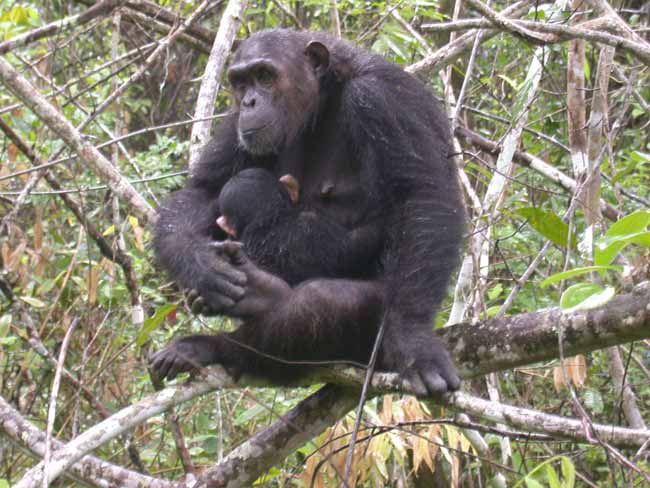Humans Likely Making Chimps Sick

Humans are likely the source of a virus that is making chimps sick in Africa, new research suggests.
After studying chimpanzees in Tanzania for the past year, Virginia Tech researcher Taranjit Kaur and her team have obtained data from molecular, microscopic and epidemiological investigations that demonstrate how the chimpanzees living there at Mahale Mountains National Park have been suffering from a respiratory disease that is likely caused by a variant of a human paramyxovirus.
Paramyxovirus causes various human diseases including mumps and measles. The virus also can cause distemper in dogs and seals, cetacean morbillivirus in dolphins and porpoises, Newcastle disease virus in birds and rinderpest virus in cattle.
The finding will be detailed in the August issue (available online in June) of the American Journal of Primatology. The research was supported by the National Science Foundation.
The new work backs up research published in a recent edition of Current Biology by investigators from European research institutes that describes evidence of human viruses in deceased chimpanzees found in West Africa’s Taï Forest.
The Mahale Mountains National Park’s free-ranging, "human-habituated" chimpanzee population provides excellent opportunities for scientists and tourists alike to study and view chimpanzees, the closest genetic relative of humans, in their natural habitat, Kaur said.
"Although evidence increasingly suggests that infectious diseases may be transmitted from research teams and eco-tourists to endangered great apes, we believe that this is still a bit of a leap and more research must be conducted in order to establish a comfortable level of proof," said Kaur, who has been unraveling the mystery in collaboration with scientists at the Centers for Disease Control and Prevention in Atlanta and researchers from Japan who are conducting behavioral studies on Mahale chimpanzees.
Sign up for the Live Science daily newsletter now
Get the world’s most fascinating discoveries delivered straight to your inbox.
"Exactly where this virus has come from and the specific route of transmission remains unclear at this time," said Kaur, but she admits that mounting evidence suggests a linkage between visiting scientists and tourists and the viruses that are threatening the endangered chimpanzee population.
A link between sick chimps and human viruses could affect the eco-tourism industry, an important source of economic development in the region and one that has been credited with protecting the animals from poachers and the dangers of shrinking habitats for great apes.
Eco-friendly field lab
Kaur's research involved the development and use of an innovative, eco-friendly field laboratory called PLUG, an acronym for "portable laboratory on uncommon ground."
After Kaur’s husband and research partner, biologist Jatinder Singh, expressed frustration over "trying to conduct space-age science with stone-age tools at geographically remote study sites," the pair collaborated with Virginia Tech’s College of Architecture and Urban Studies to develop a prototype field laboratory.
Working with Matt Lutz of CAUS and a team of university students, using "biomimicry" as the initial design direction, and incorporating state-of-the-art environmental technology to model the adaptability found in living organisms, the PLUG was born.
The field laboratory weighs much less than a ton and can be assembled and disassembled in only a few hours by as few as two people using no tools. PLUG was field-tested in March 2007 then packaged for transatlantic shipment where further 'in-situ' testing has been conducted at Mahale Mountains National Park.
The PLUG has become an integral part of the base station where Kaur, Singh, and their 4-year old daughter have been living in western Tanzania on the shores of Lake Tanganyika, the second deepest lake in the world, as part of a broader research project that seeks to establish a long-term health-monitoring program for these endangered great apes.
Living in the wild has also encouraged the family's resourcefulness. A stubborn warthog kept digging up an area near the PLUG’s external photo-voltaic cables and batteries. Their solution was to install an automobile alarm. The loud, piercing voice ordering the marauding warthog to "Step away from the car, step away from the car" every time it disturbed the laboratory seemed to solve the problem.
- Video: Jane Goodall's Wild Chimpanzees
- Vote for the Cutest Baby Animal
- Top 10 Missing Links










